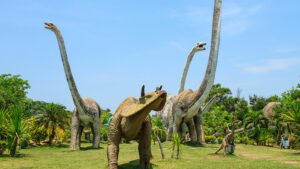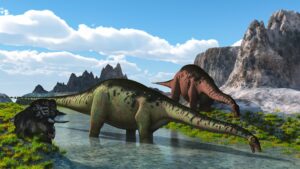Imagine stepping back in time, millions of years ago, into the age of dinosaurs. A world where colossal creatures ruled the earth, each species unique in its own way. Today, we’ll delve into the exciting realm of a new dinosaur discovery that’s shaking up the paleontological world.
So, brace yourself for an adventure into the past as we explore this recent discovery. This isn’t just another dinosaur; it’s a testament to the ever-evolving understanding of our planet’s rich and fascinating history.
New Dinosaur Discovery
 This section brings to light details about the recent dinosaur discovery, encapsulating the process of this remarkable find and its importance in scientific understanding.
This section brings to light details about the recent dinosaur discovery, encapsulating the process of this remarkable find and its importance in scientific understanding.
Paving the path to this fascinating discovery began with meticulous fieldwork. Paleontologists, armed with their geology hammers and brushes, embarked on multiple quarry excavations in search of fossil remains. Through a process of mapping, digging, identification, which took months of labor-intensive work, they finally unearthed a set of dinosaur bones. Profoundly encased in layers of rock, these fossils offered tangible proof of a hitherto unknown species of dinosaur.
The newly discovered dinosaur, classified under a distinct genus and species, is a significant milestone in paleontological research. It represents a living link to an ancient past, extending the scope of understanding regarding dinosaur diversity and evolution. This novel find not only challenges existing knowledge about dinosaurs but also offers intriguing insights into their behavior, diet, and environment.
Key Features of the New Dinosaur
 Based on comprehensive research and fossil evidence, several distinct features of the new dinosaur species have been identified. These attributes reveal a fascinating window into the prehistoric past, giving us a glimpse into the creature’s physical characteristics and behavioral tendencies.
Based on comprehensive research and fossil evidence, several distinct features of the new dinosaur species have been identified. These attributes reveal a fascinating window into the prehistoric past, giving us a glimpse into the creature’s physical characteristics and behavioral tendencies.
Residing at the intersection of archaeology and artistry, the physical traits paint an intriguing picture of the dinosaur’s form and structure. This new species flaunts a unique skeletal arrangement, standing apart from the known dinosaur species. It boasts a length of over 30 feet, making it one of the larger carnivorous dinosaurs. The head adorns sharp, serrated teeth, ideal for tearing into prey. Its long legs, suggestive of high-speed pursuits, accentuate its elegance, and the strong tail adds to the balance during motion or attacks. These attributes hint at the dinosaur’s dominant place in the food chain, illustrating its predatory nature.
Hypotheses on Behavior and Ecology
The behavioral and ecological patterns hypothesized for this new dinosaur species further intensify its captivating character. Its traits suggest it was likely a carnivore, a status supported by the shape and arrangement of its teeth, indicating it was a skilled predator. Furthermore, research proposes this dinosaur was likely a fast runner, a hypothesis solidified by the structure of this behemoth’s lengthy legs.
Fossils found close together propose that these creatures may have lived in packs, cooperating during hunts or for protecting young from potential predators. Lastly, the environment in which the fossils were found infers that these dinosaurs inhabited a lush, warm climate, probably dotted with forested areas and source of water.
Comparison With Other Dinosaur Discoveries
 The recent revelation of the newly discovered dinosaur genre offers a thrilling opportunity for archaeologists and historians to reevaluate and extend the existing dinosaur framework. Its interdisciplinary studies and analyses serve the purpose of deepening our understanding of Earth’s prehistoric life and augmenting the richness and diversity of the dinosaur universe. This section elaborates on the spectrum of comparison with other dinosaur discoveries.
The recent revelation of the newly discovered dinosaur genre offers a thrilling opportunity for archaeologists and historians to reevaluate and extend the existing dinosaur framework. Its interdisciplinary studies and analyses serve the purpose of deepening our understanding of Earth’s prehistoric life and augmenting the richness and diversity of the dinosaur universe. This section elaborates on the spectrum of comparison with other dinosaur discoveries.
Drawing parallels with known species, researchers observe similarities in certain physical characteristics distinct among carnivorous dinosaurs. It’s counterpart, the Tyrannosaurus Rex, holds striking homogeneity in terms of claw formation, sharp teeth structure for tearing flesh, and robust hind legs for rapid pursuits. Additionally, comparisons made with Velociraptors shed light on the speculated group-hunting behavior due to analogous social structures.

